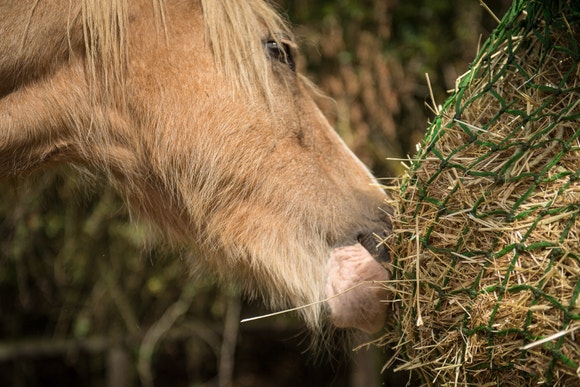#SPILLERSScience: tips for extending eating time
We all know that free access to forage is the ideal but if your horse is prone to piling on the pounds, you’ll also know it isn’t always practical and will have likely considered various ways of making restricted rations last longer. After all, avoiding long periods without forage not only supports gastric health, but is important for mental wellbeing too. This is why, together with collaborators around the world, we’ve published a number of studies evaluating different ways of feeding forage. In this blog we share a few of the findings to help you manage your good doer.
Small-holed nets
Research in 2015 compared the effect of feeding hay in four different nets – a traditional large holed haylage net and three small-holed nets designed to slow eating time. All three small-holed nets extended eating time by around 5 minutes per kilo which would equate to just 30 minutes if feeding 6kg of hay (around 2 sections from a standard rectangular bale). However, a follow-up study found that dividing 6kg of hay between three, double layered, small-holed nets could extend eating time by 2 hours compared to feeding the same amount of hay in a single net.

Haynets vs ground-based feeders
As part of a larger study, researchers recently compared the effect of different hay feeding methods on intake rate in two groups of ponies (Shetland type and Welsh Cob type):
- 3kg of hay fed from the ground
- 3kg of hay fed in a small-holed net (fully filled net)
- 1kg of hay fed in small-holed net (partially filled)
- 3kg of hay in a ground-based slow-feeder designed and built by the researchers specifically for the study
Intake rates were similar for the fully filled net and the ground-based slow-feeder; they both extended eating time compared to feeding hay directly from the ground, but the ground-based feeder allowed the ponies to maintain a more natural posture (although it’s important to note the height of the feeder was adjusted according to the height of the individual pony). However, the partially filled net was the most effective at extending eating time and might be a useful alternative if you’re able to feed forage multiple times per day or divide rations between multiple nets.
Multiple servings
Dividing forage between multiple smaller servings is common advice but can be difficult to do in practice, especially if you don’t have the luxury of keeping your horse at home. However, new research looking at behaviours around morning feed time has shown that lack of time may not be the only challenge, as dividing restricted amounts of hay and compound feed into 3 servings was found to increase aggressive behaviours compared to the same amount of feed and hay divided into just two meals a day. It is important to note that in this study the horses turned out in groups in a dry lot (grass free turnout) and the hay was fed in slow feed nets. If your horse is turned out with others and doesn’t have access to grazing, feeding hay (and ‘bucket feed’) twice per day may be a more suitable option than smaller, more frequent meals, but perhaps only if you’re able to find ways of avoiding long periods (>4-6 hours particularly during daylight hours) without forage. Look out for more information on this research in a future blog!
What’s the best option for my horse?
The beauty of science is it allows us to test management practices under controlled conditions to help identify if, how and why they may be effective. Although you may not be able to replicate the exact methods used in real life, the results of studies like these can provide valuable clues and tips for how you might be able to adapt your own horse’s management. Of course, every horse is an individual which means what works for one may not work for another. As with any feed or management change, monitoring your horse is the best practical way of assessing which option(s) may be most suitable and if changes may be needed.
- Monitor your horse’s weight and body condition regularly
- Try to look out for changes in behaviour that may indicate stress or frustration
- Several varieties of ‘slow intake’ nets and feeders are available – you may need to try different types to find the most suitable option or your horse
- Eating from a haynet may be uncomfortable for horses with arthritis in the neck
We hope this blog has given you some useful tips but for specific advice contact our team of friendly nutrition specialists here.
For additional tips and support on your horse’s weight loss journey, join the SPILLERS Slimmers’ Club here.
References
Andrea Dorothea Ellis, Michelle Fell, Katherine Luck, Laura Gill, Heather Owen, Hannah Briars, Clare Barfoot, Patricia Harris, Effect of forage presentation on feed intake behaviour in stabled horses,
Applied Animal Behaviour Science (2015), 165: 88-94, https://doi.org/10.1016/j.applanim.2015.01.010.
Andrea Dorothea Ellis, Sarah Redgate, Svitlana Zinchenko, Heather Owen, Clare Barfoot, Patricia Harris,
The effect of presenting forage in multi-layered haynets and at multiple sites on night time budgets of stabled horses, Applied Animal Behaviour Science, (2015), 171: 108-116, https://doi.org/10.1016/j.applanim.2015.08.012.
Bordin Clara , Raspa Federica , Greppi Martina , Harris Patricia , Ellis Andrea Dorothea , Roggero Angela , Palestrini Claudia , Cavallini Damiano , Bergero Domenico , Valle Emanuela, Pony feeding management: the role of morphology and hay feeding methods on intake rate, ingestive behaviors and mouth shaping, Frontiers in Veterinary Science (2024), 11, https://doi.org/10.3389/fvets.2024.1332207
E.R. Share, S.L. Mastellar, J.A. Pempek, K. Bennett-Wimbush, J.K. Suagee-Bedore, N.R. Liburt, A. Krotky, B. Cassill, P. Harris, M.L. Eastridge, Effect of meal frequency on outdoor, group-housed horse behavior, social hierarchy, and stress, Journal of Equine Veterinary Science (2025), 148, https://doi.org/10.1016/j.jevs.2025.105462
